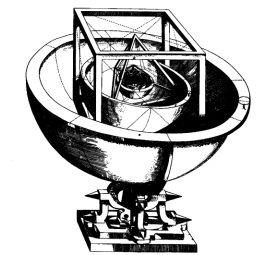
| The Science Behind Francesco Borromini's Divine Geometry |
|---|
Associate Professor (Art History)
Dept. of Visual Arts
The University of Western Ontario
London, Ontario CANADA N6A 5B7
Italian architect Francesco Borromini (1599-1667) remains an enigma for scholars of seventeenth-century architecture. His buildings rarely follow the accepted design standards of the time and their meaning eludes the traditional readings established by his contemporaries. Added to this is the problem that Borromini was not forthcoming in divulging the rationale and sources for his architectural eclecticism. There are two reasons that account for this eclecticism: the rather unique personality of the man himself, and the fact that many of his sources of inspiration were far from traditional for an architect of the time. One such source, as this paper will present, is the astronomer Johannes Kepler (1571-1603) who is best known in the annals of the history of science for his three planetary laws of motion. Kepler forged both a methodology and interpretation of the universe that appealed to Borromini on many levels. The most important would be Kepler's belief in the divine geometry ruling the structure of the universe and the manner of interpreting it. Borromini's churches of S. Carlo alle Quattro Fontane (Rome: 1638-41) and S. Ivo della Sapienza (Rome: begun 1642) involve rather novel and complex geometric designs that are both the starting and endpoint in understanding these buildings. That the meaning of these designs is indebted partly to Kepler is further confirmed by Borromini's adoption at S. Carlo and S. Ivo of the astronomer's rather unique Trinitarian interpretation of the cosmos.
 |
|
|
ABOUT THE AUTHORS
John G. Hatch is an associate professor at The University of Western
Ontario, specializing in the history of modern art, and is Acting
Chair of the Department of Visual Arts. His most recent work
focuses on the influence of contemporary physics on modern art.
Dr. Hatch's latest and upcoming
publications include an examination of the role of Machian epistemology
in the paintings and theories of the Czech artist František
Kupka, and two studies dealing with the impact of Relativity
theory on the visual conceptualizations of space found in the
work of the Russian artists El Lissitzky and Naum Gabo. Dr. Hatch
has also written on Francis Bacon, Cindy Sherman, and Robert
Rauschenberg, while undertaking a few excursions outside of the
modern period into the area of geometry and architecture, specifically
publishing an article on the possible rationale for the introduction
of alexemata in archaic Greek temples. He is currently researching
the role of relativistic theories in the architectural designs
of Theo van Doesburg and Cornelius van Eesteren, and has also
turned his attention recently to post-World War II art in Europe
and, particularly, at a potential Baroque revival in Italian
Art of 1945 to 1972.
|
John G. Hatch, "The Science Behind Francesco Borromini's Divine Geometry", pp. 127-139 in Nexus IV: Architecture and Mathematics, eds. Kim Williams and Jose Francisco Rodrigues, Fucecchio (Florence): Kim Williams Books, 2002. http://www.nexusjournal.com/conferences/N2002-Hatch.html |
|
|
|
|

Search the NNJ